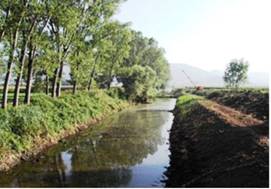Reclamation of affected areas
According to UNCCD, the main processes included in National Action Plans as leading to desertification are soil erosion, acidification, salinization and heavy metal contamination. Due to the great importance of soil erosion to desertification, it has been considered separately in other indicators such as sustainable farming, soil erosion control measures, etc. Soils affected by acidification, salinization or heavy metal contamination are considered here as affected areas sensitive to desertification. Such areas can be reclaimed by applying various techniques depending on the degradation process. Salt-affected areas can be reclaimed by irrigating with excess of good water quality accompanied by an effective drainage network for lowering ground water table. Soil acidification is mainly resulting from intensification of agriculture using high amounts of acidifying fertilizers accompanied with irrigation. Old alluvial terraces or areas with soils formed on acid parent materials show a rapid soil fertility degradation and productivity depression. Acidified soils can be reclaimed by applying calcium in the form of calcium oxide or calcium hydroxide (Fig. 71). Heavy metal contaminated soils results form local sources of contamination such as industries, metal mining, wastes disposal, etc; and diffuse contamination from the atmosphere, cars, and certain agricultural practices.
This indicator has been assessed qualitatively subject to personal judgment or by measuring electrical conductivity of the soil for salt affected soils, concentration of available heavy metals for contaminated soils, and soil pH for acidified soils. The following categories of reclamation of affected areas have been used for this project: (a) no reclamation, (b) adequate drainage, (c) adequate salt leaching, (e) adequate liming of acidified soils, (f) low heavy metals availability.


Fig. 71. Examples of reclamation of salt affected by constructing a drainage network for lowering ground water (left) and acidified soils by applying calcium-magnesium hydroxide (right)
Data for this indicator have been collected from a limited number of field sites (258 fields), corresponding to 5 study sites. The obtained data have shown that no reclamation has been conducted in 95.3% of the affected areas described. The areas identified were mainly affected by salts, corresponding to the study sites Nestos Basin Maggana-Greece, Boteti Area-Botswana, Novij Saratov-Russia, Djanybek-Russia, and Crete-Greece. Reclamation of affected areas has been identified in few cases covering 4.7% of the study field sites. These cases have been defined in the study site of Crete-Greece.